Lewis stone circle has star-shaped lightning strike
- Published

Evidence of the strike at the centre of the stone circle was found during a geophysics survey
Evidence of a "massive" lightning strike has been found at the centre of a stone circle in the Western Isles.
A single large strike, or many smaller ones on the same spot, left a star-shaped magnetic anomaly at the 4,000-year-old site in Lewis.
Scientists made the discovery at Site XI or Airigh na Beinne Bige, a hillside stone circle now consisting of a single standing stone.
The site is at the famous Calanais Standing Stones.
Scientists said the lightning strike, which was indentified in a geophysics survey, could show a potential link between the construction of ancient stone circles and the forces of nature.
They said the lightning struck some time before peat enveloped the stone circle at Site XI 3,000 years ago. The discovery is detailed in new research published online, external.

The stone circle may have attracted the lightning, say the scientists
Dr Richard Bates, of the University of St Andrews, said: "Such clear evidence for lightning strikes is extremely rare in the UK and the association with this stone circle is unlikely to be coincidental.
"Whether the lightning at Site XI focused on a tree or rock which is no longer there, or the monument itself attracted strikes, is uncertain.
"However, this remarkable evidence suggests that the forces of nature could have been intimately linked with everyday life and beliefs of the early farming communities on the island."
The discovery was made by the Calanais Virtual Reconstruction Project, a joint venture led by the University of St Andrews with standing stones trust Urras nan Tursachan and the University of Bradford and supported by funding from Highlands and Islands Enterprise.
The same project has also produced a 3D virtual model recreating another of the area's "lost" stone circle, Na Dromannan.
Its stones are today either lying flat or buried under peat.

The new discovery was made at the famous Calanais Standing Stones